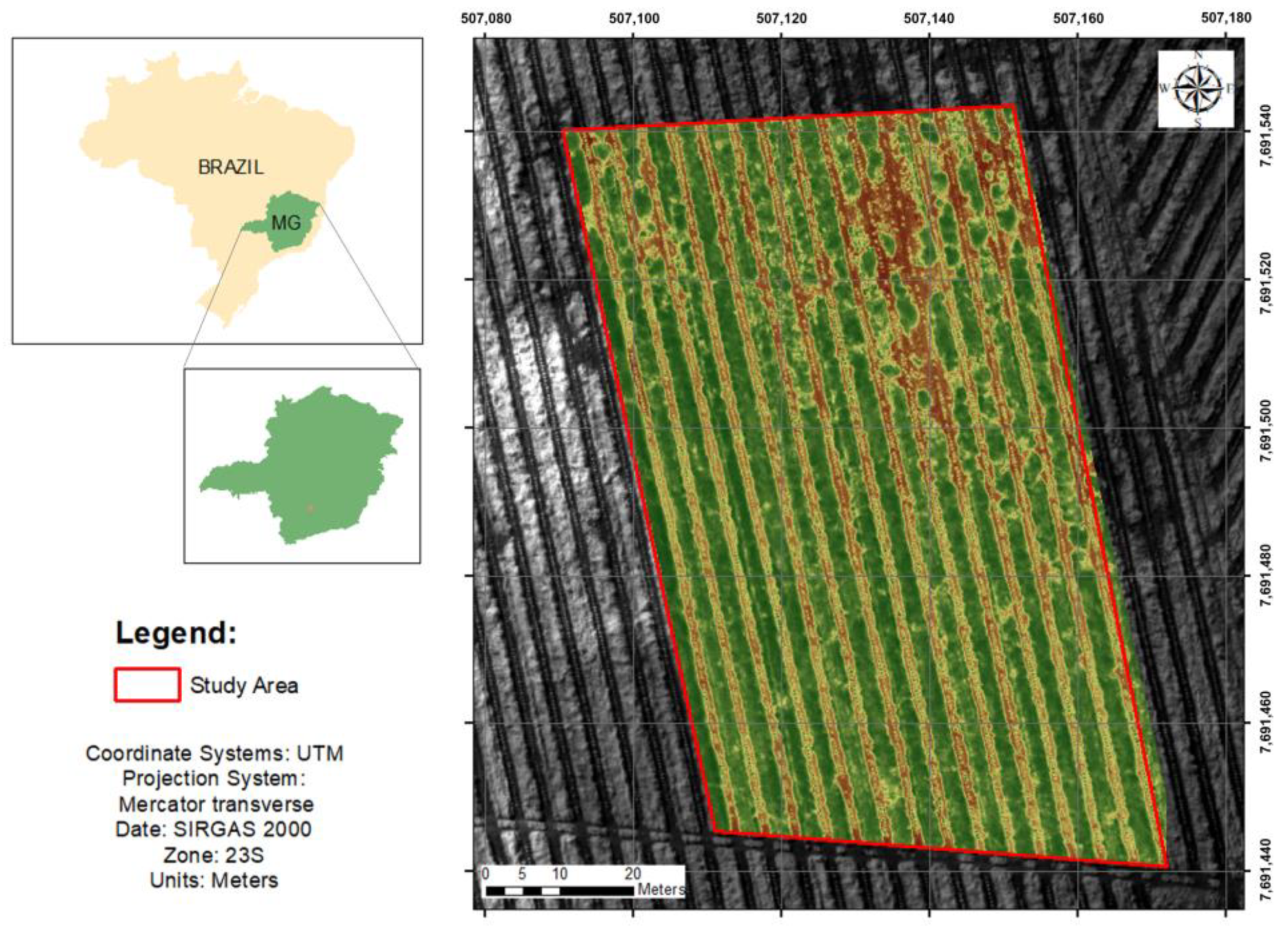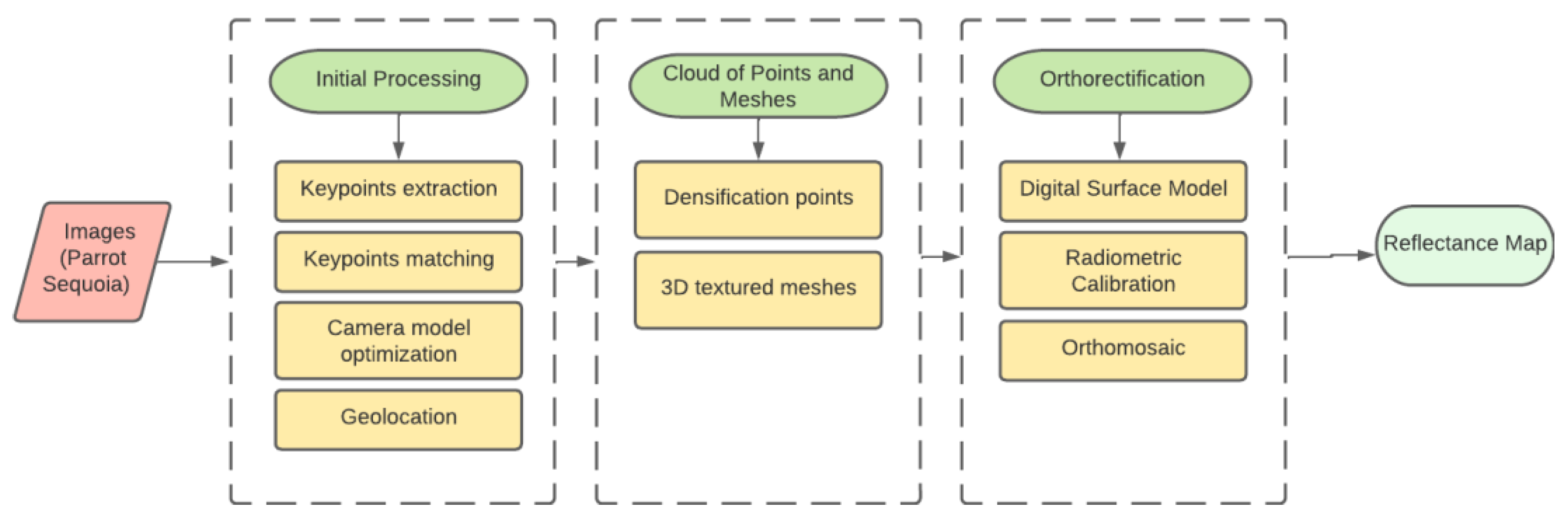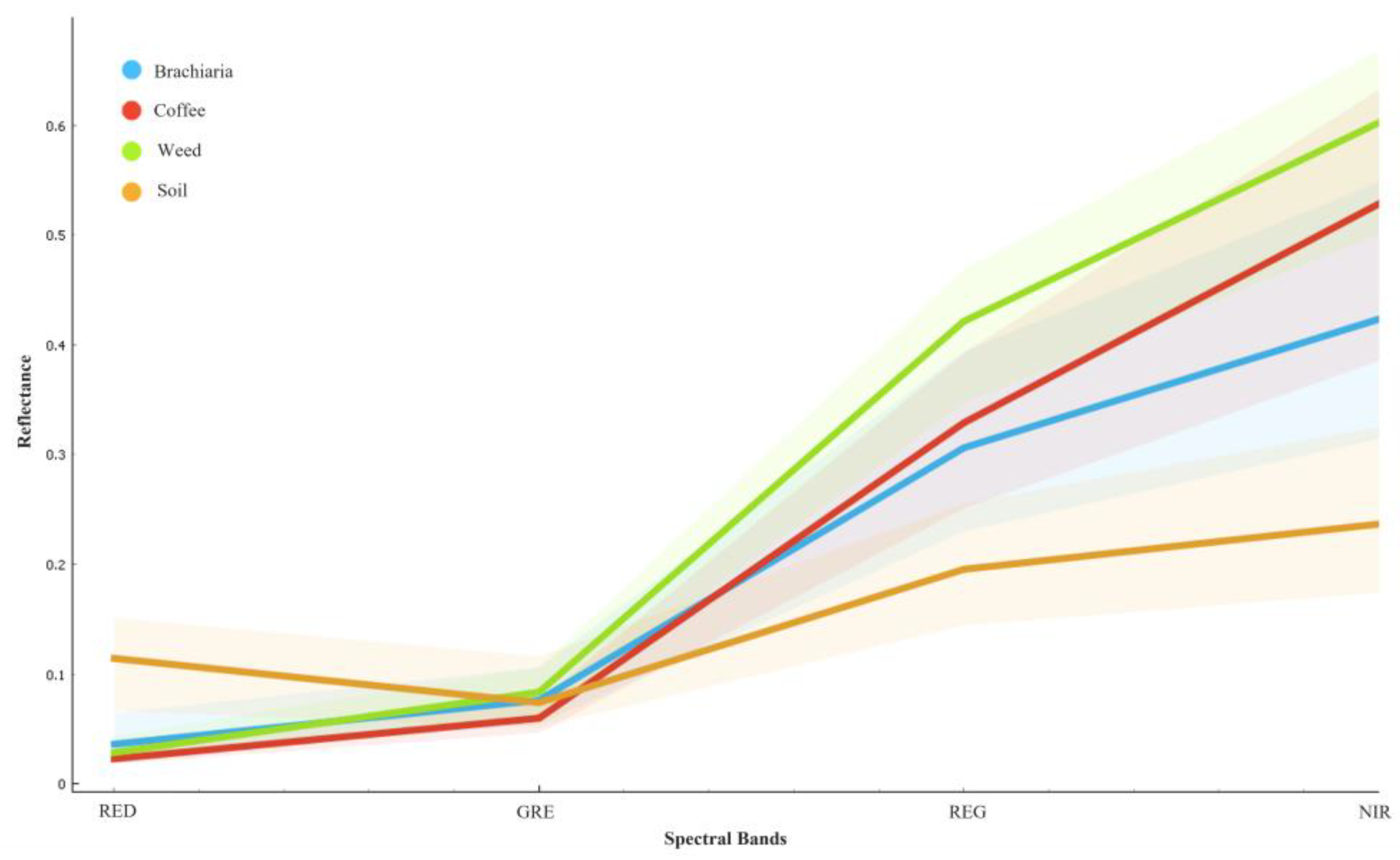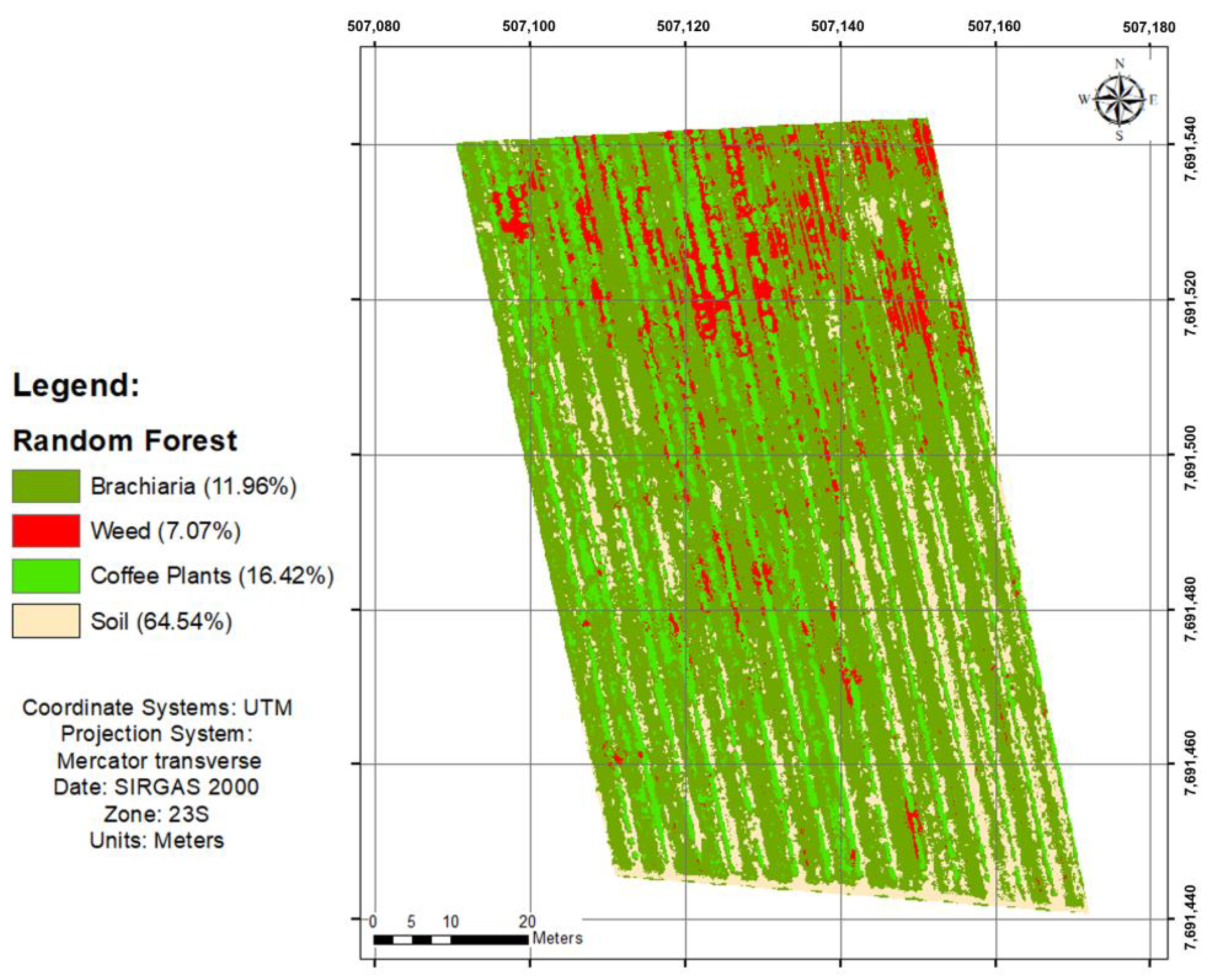Weed Detection and Mapping of a Coffee Farm by a Remotely Piloted Aircraft System
Abstract
1. Introduction
2. Materials and Methods
2.1. Study Area
2.2. Collection of Aerial Data
2.3. Image Processing
2.4. Classification Method (Training and Validation)
3. Results
3.1. Overall Classifier Accuracy
3.2. Mapping and Quantification of the Study Classes
4. Discussion
4.1. General Precision of the Classifiers
4.2. Diagnosis and Recommendation
5. Conclusions
Author Contributions
Funding
Institutional Review Board Statement
Informed Consent Statement
Data Availability Statement
Acknowledgments
Conflicts of Interest
References
- Companhia Nacional de Abastecimento-(CONAB). Acompanhamento da Safra Brasileira-CAFÉ. Obs. Agríc. 2023, 1, 1–60. [Google Scholar]
- Vargas, L.; Roman, E.S. Resistência de Plantas Daninhas a Herbicidas: Conceitos, Origem e Evolução; Embrapa Trigo: Passo Fundo, Brazil, 2006; 22p, Available online: http://www.cnpt.embrapa.br/biblio/do/p_do58.htm (accessed on 20 October 2022).
- Ahmad, J.; Muhammad, K.; Ahmad, I.; Ahmad, W.; Smith, M.L.; Smith, L.N.; Jain, D.K.; Wang, H.; Mehmood, I. Visual features based boosted classification of weeds for real-time selective herbicide sprayer systems. Comput. Ind. 2018, 98, 23–33. [Google Scholar] [CrossRef]
- Louargant, M.; Villette, S.; Jones, G.; Vigneau, N.; Paoli, J.N.; Gée, C. Weed detection by UAV: Simulation of the impact of spectral mixing in multispectral images. Precis. Agric. 2017, 18, 932–951. [Google Scholar] [CrossRef]
- Mateen, A.; Zhu, Q. Weed detection in wheat crop using UAV for precision agriculture. Pak. J. Agric. Sci. 2019, 56, 809–817. [Google Scholar] [CrossRef]
- Austin, D.F. Typification of the new world subdivisions of Ipomoea L. (Convolvulaceae). Taxon 1975, 24, 107–110. [Google Scholar] [CrossRef]
- Simão-Bianchini, R.; Pirani, J.R. Duas novas espécies de Convolvulaceae de Minas Gerais, Brasil. Hoehnea 2005, 32, 295–300. [Google Scholar]
- Felicio Barreto, L. Interferência de Ipomoea Grandifolia na Cultura do Milho. 2019. Available online: https://www.lapda.org.br/storage/downloads/interferencia-de-ipomoea-grandifolia-na-cultura-do-milho-3051.pdf (accessed on 26 October 2022).
- Mishra, A.M.; Gautam, V. Weed species identification in different crops using precision weed management: A review. In Proceedings of the CEUR Workshop Proceedings, Parma, Italy, 7–9 September 2021; Volume 2786, pp. 180–194. [Google Scholar]
- Dos Santos, L.M.; Ferraz, G.A.E.S.; Barbosa, B.D.S.; Andrade, A.D. Use of remotely piloted aircraft in precision agriculture: A review. Dyna 2019, 86, 284–291. [Google Scholar] [CrossRef]
- Sobrinho, M.F.O.; Corte, A.P.D.; Vasconsellos, B.N.; Sanqueta, C.R.; Rex, F.E.; Viana, M. Uso de Veículos Aéreos Não Tripulados (Vant) Para Mensuração de Processos Florestais. Enciclopédia Biosf. 2018, 15, 117–129. [Google Scholar] [CrossRef]
- Garcia-Ruiz, F.; Sankaran, S.; Maja, J.M.; Lee, W.S.; Rasmussen, J.; Ehsani, R. Comparison of two aerial imaging platforms for identification of Huanglongbing-infected citrus trees. Comput. Electron. Agric. 2013, 91, 106–115. [Google Scholar] [CrossRef]
- Pérez-Ortiz, M.; Peña, J.M.; Gutiérrez, P.A.; Torres-Sánchez, J.; Hervás-Martínez, C.; López-Granados, F. A semi-supervised system for weed mapping in sunflower crops using unmanned aerial vehicles and a crop row detection method. Appl. Soft Comput. J. 2015, 37, 533–544. [Google Scholar] [CrossRef]
- Whyte, A.; Ferentinos, K.P.; Petropoulos, G.P. A new synergistic approach for monitoring wetlands using Sentinels -1 and 2 data with object-based machine learning algorithms. Environ. Model. Softw. 2018, 104, 40–54. [Google Scholar] [CrossRef]
- Breiman, L. Random Forests. Mach. Learn. 2001, 45, 5–32. [Google Scholar] [CrossRef]
- Cortes, C.; Vapnik, V. Support-vector networks. Mach. Learn. 1995, 20, 273–297. [Google Scholar] [CrossRef]
- Haq, M.A. CNN Based Automated Weed Detection System Using UAV Imagery. Comput. Syst. Sci. Eng. 2021, 42, 837–849. [Google Scholar] [CrossRef]
- Rasmussen, J.; Nielsen, J.; Garcia-Ruiz, F.; Christensen, S.; Streibig, J.C. Potential uses of small unmanned aircraft systems (UAS) in weed research. Weed Res. 2013, 53, 242–248. [Google Scholar] [CrossRef]
- Peña, J.M.; Torres-Sánchez, J.; de Castro, A.I.; Kelly, M.; López-Granados, F. Weed Mapping in Early-Season Maize Fields Using Object-Based Analysis of Unmanned Aerial Vehicle (UAV) Images. PLoS ONE 2013, 8, e77151. [Google Scholar] [CrossRef]
- Torres-Sánchez, J.; López-Granados, F.; De Castro, A.I.; Peña-Barragán, J.M. Configuration and Specifications of an Unmanned Aerial Vehicle (UAV) for Early Site Specific Weed Management. PLoS ONE 2013, 8, e58210. [Google Scholar] [CrossRef]
- Rasmussen, J.; Nielsen, J.; Streibig, J.C.; Jensen, J.E.; Pedersen, K.S.; Olsen, S.I. Pre-harvest weed mapping of Cirsium arvense in wheat and barley with off-the-shelf UAVs. Precis. Agric. 2019, 20, 983–999. [Google Scholar] [CrossRef]
- Radoglou-Grammatikis, P.; Sarigiannidis, P.; Lagkas, T.; Moscholios, I. A compilation of UAV applications for precision agriculture. Comput. Netw. 2020, 172, 107148. [Google Scholar] [CrossRef]
- Khan, S.; Tufail, M.; Khan, M.T.; Khan, Z.A.; Iqbal, J.; Wasim, A. Real-time recognition of spraying area for UAV sprayers using a deep learning approach. PLoS ONE 2021, 16, e0249436. [Google Scholar] [CrossRef]
- Rahman, M.F.F.; Fan, S.; Zhang, Y.; Chen, L. A comparative study on application of unmanned aerial vehicle systems in agriculture. Agriculture 2021, 11, 22. [Google Scholar] [CrossRef]
- Yao, W.; Guo, S.; Yu, F.; Du, W.; Meng, Y.; Wang, J.; Chen, P.; Liang, X.; Xu, T.; Lan, Y. Droplet deposition and spatial drift distribution characteristics of aerial spraying based on the determination of effective swath. Int. J. Precis. Agric. Aviat. 2018, 1, 36–43. [Google Scholar] [CrossRef]
- dos Santos, H.G.; Jacomine, P.K.T.; dos Anjos, L.H.C.; de Oliveira, V.A.; Lumbreras, J.F.; Coelho, M.R.; de Almeida, J.A.; de Araújo Ilho, J.C.; de Oliveira, J.B.; Cunha, T.J.F. Sistema Brasileiro de Classificação de Solos-SBCS, 5th ed.; Brazilian Agricultural Research Corporation: Brasília, Brazil, 2018; Available online: https://www.embrapa.br/busca-de-publicacoes/-/publicacao/1094003/sistema-brasileiro-de-classificacao-de-solos (accessed on 13 November 2022).
- Alvares, C.A.; Stape, J.L.; Sentelhas, P.C.; de Moraes Gonçalves, J.L.; Sparovek, G. Köppen’s climate classification map for Brazil. Meteorol. Z. 2013, 22, 711–728. [Google Scholar] [CrossRef] [PubMed]
- Ministry of Agriculture. Livestock and Supply Brazil-MAPA; Ministry of Agriculture: Brasília, Brasil, 2018. Available online: https://sistemas.agricultura.gov.br/snpc/cultivarweb/cultivares_registradas.php (accessed on 8 May 2022).
- Chang, C.C.; Lin, C.J. LIBSVM: A Library for support vector machines. ACM Trans. Intell. Syst. Technol. 2011, 2, 1–27. [Google Scholar] [CrossRef]
- Gislason, P.O.; Benediktsson, J.A.; Sveinsson, J.R. Random forests for land cover classification. Pattern Recognit. Lett. 2006, 27, 294–300. [Google Scholar] [CrossRef]
- Balzter, H.; Cole, B.; Thiel, C.; Schmullius, C. Mapping CORINE land cover from Sentinel-1A SAR and SRTM digital elevation model data using random forests. Remote Sens. 2015, 7, 14876–14898. [Google Scholar] [CrossRef]
- Breiman, L. Manual On Setting Up, Using, and Understanding Random Forests V3.1; Berkeley University: Berkeley, CA, USA, 2001; p. 33. Available online: http://journal.um-surabaya.ac.id/index.php/JKM/article/view/2203 (accessed on 10 November 2022).
- Chinchor, N. MUC-4 evaluation metrics. In Proceedings of the 4th Message Understanding Conference, MUC 1992-Proceedings, McLean, VA, USA, 16–18 June 1992; pp. 22–29. [Google Scholar] [CrossRef]
- Cohen, J. A Coefficient of Agreement for Nominal Scales. Educ. Psychol. Meas. 1960, 20, 37–46. [Google Scholar] [CrossRef]
- Pontius, R.G.; Millones, M. Death to Kappa: Birth of quantity disagreement and allocation disagreement for accuracy assessment. Int. J. Remote Sens. 2011, 32, 4407–4429. [Google Scholar] [CrossRef]
- FAO: Food and Agriculture Organization of the United Nations. Map Accuracy Assessment and Area Estimation: A Practical Guide; FAO: Rome, Italy, 2016; Available online: http://www.fao.org/3/a-i5601e.pdf (accessed on 3 April 2022).
- Landis, J.R.; Koch, G.G. A One-Way Components of Variance Model for Categorical Data. Biometrics 1977, 33, 671. [Google Scholar] [CrossRef]
- Mandrekar, J.N. Receiver operating characteristic curve in diagnostic test assessment. J. Thorac. Oncol. 2010, 5, 1315–1316. [Google Scholar] [CrossRef]
- Mahdianpari, M.; Salehi, B.; Mohammadimanesh, F.; Motagh, M. Random forest wetland classification using ALOS-2 L-band, RADARSAT-2 C-band, and TerraSAR-X imagery. ISPRS J. Photogramm. Remote Sens. 2017, 130, 13–31. [Google Scholar] [CrossRef]
- de Almeida Furtado, L.F.; Silva, T.S.F.; de Moraes Novo, E.M.L. Dual-season and full-polarimetric C band SAR assessment for vegetation mapping in the Amazon várzea wetlands. Remote Sens. Environ. 2016, 174, 212–222. [Google Scholar] [CrossRef]
- Wang, A.; Zhang, W.; Wei, X. A review on weed detection using ground-based machine vision and image processing techniques. Comput. Electron. Agric. 2019, 158, 226–240. [Google Scholar] [CrossRef]
- Chicchón Apaza, M.Á.; Monzón, H.M.B.; Garrido, R.P.A. Semantic Segmentation of Weeds and Crops in Multispectral Images by Using a Convolutional Neural Networks Based on U-Net. Commun. Comput. Inf. Sci. 2019, 473–485. [Google Scholar] [CrossRef]
- Ulaby, F.T.; Allen, C.T.; Eger, G.; Kanemasu, E. Relating the microwave backscattering coefficient to leaf area index. Remote Sens. Environ. 1984, 14, 113–133. [Google Scholar] [CrossRef]
- Knipling, E.B. Physical and physiological basis for the reflectance of visible and near-infrared radiation from vegetation. Remote Sens. Environ. 1970, 1, 155–159. [Google Scholar] [CrossRef]
- Gardner, B.R. Techniques for Remotely Monitoring Canopy Development and Estimating Grain Yield of Moisture Stressed Corn; CAMAC Progress Report 83-9; Institute of Agriculture and Natural Resources–University of Nebraska-Lincoln: Lincoln, Nebraska, 1983; p. 187. [Google Scholar]
- Ramana Rao, T.V. Monitoring Water Stress in Soybeans with Remote Sensing Techniques; The University of Nebraska-Lincoln: Lincoln, Nebraska, 1985. [Google Scholar]
- Dyrmann, M.; Skovsen, S.; Stigaard Laursen, M.; Nyholm Jørgensen, R. Using a fully convolutional neural network for detecting locations of weeds in images from cereal fields An intelligent system for assessing the quality of the cereal sowing. View project FutureCropping View project. In Proceedings of the 14th International Conference on Precision Agriculture, Montreal, QC, Canada, 24–27 June 2018; Available online: https://www.researchgate.net/publication/355039118 (accessed on 10 April 2022).
- Alimboyong, R.P.; Hernandez, C.R.; Medina, A.A. Classification of SD-OCT images using Deep learning approach. In Proceedings of the 2017 IEEE International Conference on Signal and Image Processing Applications (ICSIPA), Kuching, Malaysia, 12–14 September 2017; pp. 3–6. [Google Scholar]
- López-Granados, F.; Torres-Sánchez, J.; Serrano-Pérez, A.; de Castro, A.I.; Mesas-Carrascosa, F.J.; Peña, J.M. Early season weed mapping in sunflower using UAV technology: Variability of herbicide treatment maps against weed thresholds. Precis. Agric. 2016, 17, 183–199. [Google Scholar] [CrossRef]
- de Castro, A.I.; Torres-Sánchez, J.; Peña, J.M.; Jiménez-Brenes, F.M.; Csillik, O.; López-Granados, F. An automatic random forest-OBIA algorithm for early weed mapping between and within crop rows using UAV imagery. Remote Sens. 2018, 10, 285. [Google Scholar] [CrossRef]
- Zhu, D.S.; Pan, J.Z.; He, Y. Identification methods of crop and weeds based on Vis/NIR spectroscopy and RBF-NN model. Guang Pu Xue Yu Guang Pu Fen Xi= Guang Pu 2008, 28, 1102–1106. [Google Scholar]
- Gibson, K.D.; Dirks, R.; Medlin, C.R.; Johnston, L. Detection of Weed Species in Soybean Using Multispectral Digital Images. Weed Technol. 2004, 18, 742–749. [Google Scholar] [CrossRef]
- Rizzardi, M.A.; Luiz, A.R.; Roman, E.S.; Vargas, L. Temperatura cardeal e potencial hídrico na germinação de sementes de corda-de-viola (Ipomoea triloba). Planta Daninha 2009, 27, 13–21. [Google Scholar] [CrossRef]
- Umamaheswari, S.; Arjun, R.; Meganathan, D. Weed Detection in Farm Crops using Parallel Image Processing. In Proceedings of the 2018 Conference on Information and Communication Technology (CICT), Jabalpur, India, 26–28 October 2018. [Google Scholar] [CrossRef]
- Fialho, C.M.T.; França, A.C.; Tironi, S.P.; Ronchi, C.P.; Silva, A.A. Interferência de plantas daninhas sobre o crescimento inicial de Coffea arabica. Planta Daninha 2011, 29, 137–147. [Google Scholar] [CrossRef]








| Algorithm | Global Accuracy | Kappa Index | F1 | AUC |
|---|---|---|---|---|
| RF | 99.24 | 98.86 | 98.91 | 99.91 |
| SVM | 98.71 | 98.08 | 96.52 | 99.83 |
| Classes | Reference | ||||||
|---|---|---|---|---|---|---|---|
| Brachiaria | Coffee | Weed | Soil | Total | ET1 (%) | ||
| Prediction | Brachiaria | 481 | 0 | 0 | 0 | 481 | 0 |
| Coffee | 0 | 400 | 2 | 11 | 413 | 3.15 | |
| Weed | 0 | 0 | 372 | 0 | 372 | 0 | |
| Soil | 0 | 5 | 1 | 1213 | 1219 | 0.50 | |
| Total | 481 | 405 | 375 | 1224 | 2485 | - | |
| ET2 (%) | 0 | 1.23 | 0.80 | 0.89 | - | - | |
| Classes | Reference | ||||||
|---|---|---|---|---|---|---|---|
| Brachiaria | Coffee | Weed | Soil | Total | ET1 (%) | ||
| Prediction | Brachiaria | 481 | 0 | 0 | 0 | 481 | 0 |
| Coffee | 0 | 392 | 2 | 15 | 409 | 4.15 | |
| Weed | 0 | 1 | 371 | 0 | 372 | 0.26 | |
| Soil | 0 | 12 | 2 | 1209 | 1223 | 1.15 | |
| Total | 481 | 405 | 375 | 1224 | 2485 | - | |
| ET2 (%) | 0 | 3.21 | 1.07 | 1.22 | - | - | |
Disclaimer/Publisher’s Note: The statements, opinions and data contained in all publications are solely those of the individual author(s) and contributor(s) and not of MDPI and/or the editor(s). MDPI and/or the editor(s) disclaim responsibility for any injury to people or property resulting from any ideas, methods, instructions or products referred to in the content. |
© 2023 by the authors. Licensee MDPI, Basel, Switzerland. This article is an open access article distributed under the terms and conditions of the Creative Commons Attribution (CC BY) license (https://creativecommons.org/licenses/by/4.0/).
Share and Cite
Bento, N.L.; Ferraz, G.A.e.S.; Amorim, J.d.S.; Santana, L.S.; Barata, R.A.P.; Soares, D.V.; Ferraz, P.F.P. Weed Detection and Mapping of a Coffee Farm by a Remotely Piloted Aircraft System. Agronomy 2023, 13, 830. https://doi.org/10.3390/agronomy13030830
Bento NL, Ferraz GAeS, Amorim JdS, Santana LS, Barata RAP, Soares DV, Ferraz PFP. Weed Detection and Mapping of a Coffee Farm by a Remotely Piloted Aircraft System. Agronomy. 2023; 13(3):830. https://doi.org/10.3390/agronomy13030830
Chicago/Turabian StyleBento, Nicole Lopes, Gabriel Araújo e Silva Ferraz, Jhones da Silva Amorim, Lucas Santos Santana, Rafael Alexandre Pena Barata, Daniel Veiga Soares, and Patrícia Ferreira Ponciano Ferraz. 2023. "Weed Detection and Mapping of a Coffee Farm by a Remotely Piloted Aircraft System" Agronomy 13, no. 3: 830. https://doi.org/10.3390/agronomy13030830
APA StyleBento, N. L., Ferraz, G. A. e. S., Amorim, J. d. S., Santana, L. S., Barata, R. A. P., Soares, D. V., & Ferraz, P. F. P. (2023). Weed Detection and Mapping of a Coffee Farm by a Remotely Piloted Aircraft System. Agronomy, 13(3), 830. https://doi.org/10.3390/agronomy13030830









